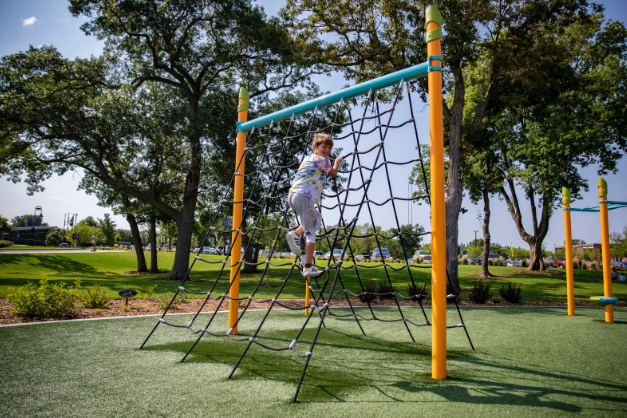Designing a playground that caters to all ages is a complex yet rewarding challenge. It requires careful consideration of various factors such as safety, engagement, accessibility, and educational value. Here’s a comprehensive guide on creating a playground landscape that is inclusive, fun, and safe for everyone from toddlers to adults.
Start with Safety
Safety is the cornerstone of any playground design. The use of soft landing surfaces, like poured-in-place rubber or engineered wood fiber, significantly reduces the risk of injuries. The American Society for Testing and Materials (ASTM) standards recommend a minimum of 12 inches of loose-fill materials or 2-3 inches of synthetic materials for areas with equipment over 6 feet high. This ensures that falls are cushioned effectively.
Zone for Different Age Groups
A well-designed playground includes distinct zones tailored for different age groups, ensuring that activities are age-appropriate and engaging. For instance:
- Toddlers (ages 1-3): This area should include low platforms, small slides, and tactile panels that support sensory development and motor skills.
- Children (ages 4-12): Incorporate more challenging equipment like climbing structures, larger slides, and swings. These encourage physical activity and social interaction.
- Teens and Adults: Design spaces with fitness equipment or obstacle courses that promote health and well-being, alongside areas for relaxation and socializing.
Incorporate Natural Elements
Integrating natural elements not only enhances the aesthetic appeal of the playground but also promotes a connection with nature. Natural playgrounds using elements like wood, stones, and water features encourage imaginative play and interaction with the environment. According to a study from Cornell University, natural playgrounds can increase children's creativity by up to 20%.

Ensure Accessibility
Accessibility is key to inclusive playground design. According to the Americans with Disabilities Act (ADA), playgrounds must be accessible to children of all abilities. This includes smooth surfacing that accommodates wheelchairs, sensory-friendly activities for children with sensory processing disorders, and visually appealing elements for visual impairments. Providing ramps and adaptive swing sets ensures that every child can participate in play.
Use Durable Materials
Choosing the right materials is essential for durability and maintenance. Materials like high-quality plastics, metals, and treated woods withstand harsh weather and heavy use. Ensure that all materials are non-toxic and environmentally friendly, to keep both children and the environment safe.
Engage the Community
Involving the community in the playground design process can ensure the playground meets the specific needs of its users. Gather feedback through surveys or community meetings. This engagement can help tailor the design to reflect the community’s desires and increase the sense of ownership and pride among the users.
Case Studies and Success Stories
Real-world examples like the Clemyjontri Park in Virginia showcase a playground designed for all ages and abilities. The park features a Liberty Swing, a wheelchair-accessible swing, and a carousel that accommodates wheelchairs, proving that inclusive design is both feasible and beneficial.
In conclusion, a well-thought-out playground landscape that caters to all ages involves meticulous planning and a deep understanding of the needs of various user groups. By prioritizing safety, inclusivity, and natural integration, playgrounds can become a hub of activity and joy for the entire community.